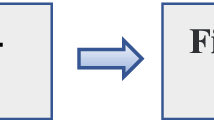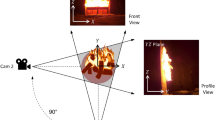Abstract
A computational model is developed to estimate the heat release rate and fuel type of circular pool fires by analyzing the videos with recognizable flames. The model can be used in both static and mobile platforms. The pool diameter, mean flame height, heat release rate and fuel type are estimated using image recognition technique on flame videos and inverse modelling with traditional fire dynamics theories. A set of experimental videos from different sources are used to validate the model. During image recognition, the model isolates the flame from the non-flame elements in each frame using the “automatic seed placement and region growing” method. The method is found to be effective in non-flame elements removal and improves the flexibility of the model to wide range of flame videos. To automatically determine the pool diameter, fast Fourier transform (FFT) is involved to identify the flame pulsation frequency that is used as the input of inverse modelling. It is found that a sampling duration of 10 s to 20 s gives the most reliable predictions to the flame pulsation frequency for the current set of videos. A shorter duration is not sufficient for FFT to recognize the correct main frequency of the signal while a longer duration increases the low frequency components caused by the unsteady flame. Compared to the traditional fire dynamics theories with power indexes of input variables less than 1, the inverse modelling enlarges the error in the modelling results. Therefore, the main weakness of current model is perhaps the enlarged uncertainty led by the inverse modelling conducted with the traditional theories which are empirical, although the current predictions to the experiments are acceptable. Moreover, the current model divides the pool fires into three categories and based on the predicted pool diameter and heat release rate the fuel type can be estimated, which might benefit the hazard analysis in certain circumstances. Finally, a cross-platform comparison shows that the mobile devices can be considered for fire applications although it is still less powerful than personal computers.

Calculated adopting [38]










Similar content being viewed by others
References
Lipsman A (2017) Mobile matures as the cross-platform era emerges. U.S. cross-platform future in focus report. https://www.comscore.com/ita/Insights/Blog/Mobile-Matures-as-the-Cross-Platform-Era-Emerges. Accessed 20 Nov 2018
eMarketer (2015) In China, tier 1 cities rule for smartphone usage. https://www.emarketer.com/Article/China-Tier-1-Cities-Rule-Smartphone-Usage/1012873. Accessed 20 Nov 2018
Rui B, Liu P (2009) CCTV fire fallout: twelve detained; Chinese react online. The Economic Observer. 12 February 2009
Heskestad G (1991) A reduced scale mass fire experiment. Combust Flame 83:293–301
Becker HA, Liang D (1978) Visible length of vertical free turbulent diffusion flames. Combust Flame 32:115–137
McCaffrey B (1995) Flame height. In: DiNenno PJ (ed) The SFPE handbook of fire protection engineering, 2nd edn. Society of Fire Protection Engineers and National Fire Protection Association, Quincy, pp 2-1–2-8
Kung HC, Stavrianidis P (1982) Buoyant plumes of large-scale pool fires. In: Symposium (international) on combustion, vol 19, no 1. Elsevier, pp 905–912
Wood BD, Blackshear JR, Eckert RG (1971) Mass fire model: an experimental study of the heat transfer to liquid fuel burning from a sand-filled pan burner. Combust Sci Technol 4(1):113–129
Thomas PH, Hinkley PL, Theobald CR, Simms DL (1963) Investigations into the flow of hot gases in roof venting. Fire research technical paper no. 7, HMSO, London
McCaffrey BJ (1979) Purely buoyant diffusion flames: some experimental results. NBSIR 79-1910, National Bureau of Standards
Zukoski EE, Kubota T, Cetegen B (1980) Entrainment in fire plumes. Fire Saf J 3:107–121
Heskestad G (1995) Fire plumes. In: DiNenno PJ (ed) SFPE handbook of fire protection engineering, 2nd ed. National Fire Protection Association, Quincy
Ma TG, Quintiere JG (2003) Numerical simulation of axi-symmetric fire plumes: accuracy and limitations. Fire Saf J 38:467–492
Heskestad G (1997) Flame heights of fuel arrays with combustion in depth. Fire Saf Sci 5: 427–438. https://doi.org/10.3801/iafss.fss.5-427
Audouin L, Kolb G, Torero JL, Most JM (1995) Average centreline temperatures of a buoyant pool fire obtained by image processing of video recordings. Fire Saf J 24:167–187
Gao Z, Ji J, Wan H, Li K, Sun J (2015) An investigation of the detailed flame shape and flame length under the ceiling of a channel. Proc Combust Inst 35:2657–2664
Maynard TB, Butta JW (2018) A physical model for flame height intermittency. Fire Technol 54:135–161. https://doi.org/10.1007/s10694-017-0678-7
Byram GM, Nelson RM (1970) The modeling of pulsating fires. Fire Technol 6(2):102–110
Cetegen BM, Ahmed TA (1993) Experiments on the periodic instability of buoyant plumes and pool fires. Combust Flame 93(1–2):157–184
Fang J, Tu R, Guan J, Wang J, Zhang Y (2011) Influence of low air pressure on combustion characteristics and flame pulsation frequency of pool fires. Fuel 90:2760–2766
Zhou K, Qian J, Liu N, Zhang S (2018) Validity evaluation on temperature correction methods by thermocouples with different bead diameters and application of corrected temperature. Int J Therm Sci 125:305–312
Maynard T, Princevac M (2012) The application of a simple free convection model to the pool fire pulsation problem. Combust Sci Technol 184(4):505–516
Hamins A, Yang JC, Kashiwagi T (1992) An experimental investigation of the pulsation frequency of flames. In: Symposium (international) on combustion, vol 24, no 1. Elsevier, pp 1695–1702
Tieszen SR, Ohern TJ, Schefer RW, Weckman EJ, Blanchat TK (2002) Experimental study of the flow field in and around a one meter diameter methane fire. Combust Flame 129(4):378–391
Luo KH (2004) Instabilities, entrainment and mixing in reacting plumes. Eur J Mech B Fluids 23(3):443–460
Malalasekera WMG, Versteeg HK, Gilchrist K (1996) A review of research and an experimental study on the pulsation of buoyant diffusion flames and pool fires. Fire Mater 20(6):261–271
Cox G (ed) (1995) Combustion fundamentals of fire. Academic Press, Cambridge
Stratton BJ (2005) Determining flame height and flame pulsation frequency and estimating heat release rate from 3D flame reconstruction. University of Canterbury, Christchurch
Xin Y (2014) Estimation of chemical heat release rate in rack storage fires based on flame volume. Fire Saf J 63:29–36
Mason PS, Fleischmann CM, Rogers CB, McKinnon AE, Unsworth K, Spearpoint M (2009) Estimating thermal radiation fields from 3d flame reconstruction. Fire Technol 45:1–22. https://doi.org/10.1007/s10694-008-0041-0
Sikanen T, Hostikka S (2016) Modeling and simulation of liquid pool fires with in-depth radiation absorption and heat transfer. Fire Saf J 80:95–109
Schneider ME, Kent LA (1989) Measurements of gas velocities and temperatures in a large open pool fire. Fire Technol 25:51–80. https://doi.org/10.1007/BF01039723
Sudheer S, Prabhu SV (2012) Measurement of flame emissivity of hydrocarbon pool fires. Fire Technol 48:183–217. https://doi.org/10.1007/s10694-010-0206-5
Zhou K, Liu N, Zhang L, Satoh K (2014) Thermal radiation from fire whirls: revised solid flame model. Fire Technol 50:1573–1587. https://doi.org/10.1007/s10694-013-0360-7
Hu L, Qiu Z, Lu K, Tang F (2015) Window ejected flame width and depth evolution along facade from under-ventilated enclosure fires. Fire Saf J 76:44–53.
Rein G, Lautenberger C, Fernandez-Pello AC, Torero JL, Urban DL (2006) Application of genetic algorithms and thermogravimetry to determine the kinetics of polyurethane foam in smoldering combustion. Combust Flame 146:95–108
Oliphant TE (2006) A guide to NumPy, vol 1. Trelgol Publishing, Spanish Fork
Babrauskas V (2015) Chapter 26 Heat Release Rates. In: SFPE handbook of fire protection engineering, 5th edn. National Fire Protection Association, Quincy, pp 865–866
Karlsson B, Quintiere JG (2000) Enclosure fire dynamics. CRC Press, Washington, p 30
Tewarson A (2002) Generation of heat and chemical compounds in fires. In: DiNenno PJ (ed) SFPE handbook of fire protection engineering, 3rd edn. Society of Fir Protection Engineers, Boston, pp 3–110
Burger W, Burge MJ (2010) Principles of digital image processing core algorithms. Springer, Berlin
Otsu N (1975) A threshold selection method from gray level histograms. Automatica 11(285–296):23–27
Zucker SW (1976) Region growing: childhood and adolescence. Comput Graph Image Process 5:382–399
Peterson B (2018) Python 2.7.15 released. Python Insider. The Python Core Developers
Virbel M, Hansen TE, Lobunets O (2011) Kivy-a framework for rapid creation of innovative user interfaces. Mensch & Computer Workshopband, pp 69–73
Tang W, Gorham DJ, Finney MA, Mcallister S, Cohen J, Forthofer J, Gollner MJ (2017) An experimental study on the intermittent extension of flames in wind-driven fires. Fire Saf J 91:742–748. https://doi.org/10.1016/j.firesaf.2017.03.030
McAllister S, Finney M (2016) The effect of wind on burning rate of wood cribs. Fire Technol 52:1035–1050. https://doi.org/10.1007/10.1007/s10694-015-0536-4
Acknowledgements
This work was supported by National Natural Science Foundation of China (NSFC) under Grant Nos. 51876148 and 51706216 and the Fund of National Engineering Research Center for Water Transport Safety (No. 201803).
Author information
Authors and Affiliations
Corresponding author
Additional information
Publisher's Note
Springer Nature remains neutral with regard to jurisdictional claims in published maps and institutional affiliations.
Rights and permissions
About this article
Cite this article
Li, K., Mao, S. & Feng, R. Estimation of Heat Release Rate and Fuel Type of Circular Pool Fires Using Inverse Modelling Based on Image Recognition Technique. Fire Technol 55, 667–687 (2019). https://doi.org/10.1007/s10694-018-0795-y
Received:
Accepted:
Published:
Issue Date:
DOI: https://doi.org/10.1007/s10694-018-0795-y




